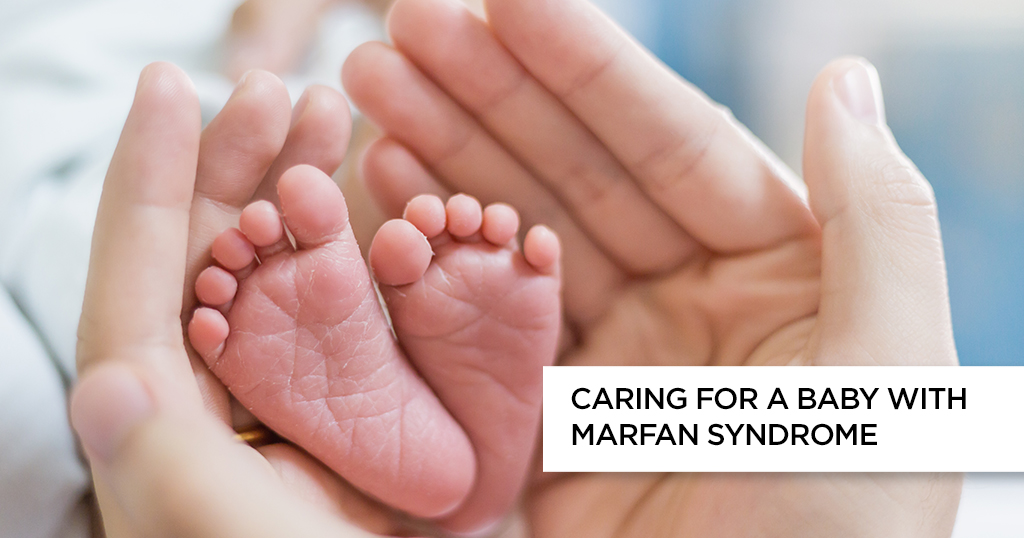Caring for a Baby With Marfan Syndrome


Marfan syndrome or MFS is a genetic condition that affects the connective tissue of the body. Connective tissue provides support, elasticity, and strength to your body while securing the organs and other vital parts (including cartilage, tendons, blood vessels, and heart valves, among others) together. This syndrome affects your skeleton, eyes, heart, and blood vessels.
What is Marfan Syndrome
Most people who have Marfan disease are tall and thin. Their arms, legs, toes, and fingers are disproportionately long. This inherited condition can cause mild to severe damages to the body. For example, if this disease affects your aorta, the main artery that transports blood from your heart to the other parts of your body, it could be life-threatening.
Marfan syndrome affects the gene that allows your body to produce collagen, a protein that holds the entire body in a frame, forming a structure that provides strength and elasticity to your body.
People with this genetic condition get the defective gene from the affected parent. Every child of a Marfan parent has an even chance (fifty-fifty) of receiving the abnormal gene. Around 25% of people with Marfan disorder do not inherit the defective gene from either of their parents. In such cases, the mutation occurs spontaneously.
Symptoms of Marfan Syndrome
The symptoms of Marfan disease differ from one person to the other and even amongst family members. Some show mild Marfanoid features, while some suffer from life-threatening conditions. However, this genetic abnormality worsens with age, in most cases.
Some of the common signs and symptoms of this disease include the following:
● Tall and slim stature.
● Flat feet.
● Unreasonably long legs, arms, and fingers
● Breastbone protruding outward or sinking inward.
● Heart murmurs.
● Crowded teeth.
● Arched and high palate.
● Abnormally arched spine.
● Severe nearsightedness.
In case you, your child, or any of your family members exhibit the features, get in touch with your doctor. If your doctor feels that there is a problem, they are likely to refer you to a specialist for detailed evaluation.
Request an appointment at Apollo Hospitals
Call 1860-500-1066 to book an appointment
Complications Due to Marfan Syndrome
This inherited condition affects both men and women equally, regardless of their ethnic groups and races. Most importantly, as it is a genetic disorder, having a parent with this condition is one of the biggest risks.
Cardiovascular complications
The most severe complications of this disease are related to the heart and blood vessels. Connective tissue defects can lead to the weakening of the aorta and might result in the following conditions:
● Aortic aneurysm: A condition in which an abnormal protrusion or bulge develops in the wall of the aorta. In people with this syndrome, this bulge is most likely to occur at the point where the aorta leaves the heart, the aortic root.
● Aortic dissection: There are three layers of the aortic wall – the inner, middle, and outer. An aortic dissection is a life-threatening condition in which a small tear develops in the inner wall of the aorta. This tear allows the blood to surge through it, which as a result, dissects (separates) the innermost layer from the middle layers. This dissection can lead to severe back or chest pain. In case the blood-filled vessel bursts through the outer wall of the aorta, it can be fatal.
● Valve malformations: The tissue in the heart valves of a person with Marfan syndrome is weaker than people who do not have this condition. It can result in tears or stretches in the valvular tissue and abnormal functioning of the heart valves. And, when these valves are unable to work properly, your heart has to compensate and work harder. It can ultimately lead to heart failure.
Eye complications
Following are the eye complications associated with the disease:
● Lens dislocation: When the supporting structures of your eyes are weak, the lens can dislocate from its actual position. This condition is known as ectopia lentis in medical terminology. Lens dislocation occurs in more than 50% of people with Marfan disease.
● Retinal tear: Retina is the thin, light-sensitive, innermost lining of the eye that layers the back of your eyes. In people with this disease, the risk of a retinal tear is high.
● Early-onset of eye problems: Eye problems, like cataracts, glaucoma, and others, tend to affect people with Marfan abnormality at an early age.
Skeletal complications
The skeletal complications associated with this disease include – abnormally curved spine (scoliosis), abnormal rib development, protruding or sunken breastbone, etc. Moreover, issues like back and foot pain are common with this health condition.
Complications with pregnancy
The weakening of the aortic walls is a common aspect of this genetic syndrome. When a woman is pregnant, her heart pumps more blood than normal. It can put extra pressure on her aorta and might increase the chances of aortic dissection.
Diagnosis of Marfan Syndrome
Diagnosing Marfan syndrome can be challenging for medical professionals because there are many anomalies associated with connective tissue that exhibit similar symptoms as Marfan. Therefore, the diagnosis of this disease depends on a set of specified clinical criteria known as the Ghent criteria. The Ghent criteria facilitate proper identification of the signs and symptoms of the disease while enhancing patient management practices. Genetic testing, heart related tests, and eye tests can be helpful.
Request an appointment at Apollo Hospitals
Call 1860-500-1066 to book an appointment
Treatment for Marfan Syndrome
There is no cure for this disease. The treatments rely on managing the signs and symptoms and preventing the complications of this condition. Regular monitoring is essential to keep an eye on the progression of the disease. Earlier, people with this genetic disease often died at a very young age. However, due to the concept of periodical screening and medical advancement, people can expect a better lifespan now.
Medications
Your doctor can prescribe medication for lowering your blood pressure to prevent the enlargement of aorta and reduce the risks of aortic dissection.
Your doctor might suggest contact lenses or glasses to correct the eye-related issues associated with this syndrome.
Surgical procedures
Your doctor might prescribe the following procedures based on the signs and symptoms you have:
● Aortic repair:
In case your aorta enlarges rapidly, or its size measures 45 mm to 50 mm (2 inches), your doctor might suggest an aortic repair surgery. It is a surgical procedure in which the doctor will replace a part of your aorta with a synthetic tube. This surgery can prevent aortic ruptures. Moreover, your doctor might recommend an aortic valve replacement as well.
If you are at risk of aortic rupture, your doctor might suggest that you do not participate in competitive sports, adventure sport, and several other recreational activities. Involving in such activities is likely to increase your blood pressure and put extra strain on your aorta. However, you can go for less intense sports and activities as advised by your doctor.
● Scoliosis treatment:
If you have scoliosis or an abnormally curved spine, it is advisable to visit a spine expert. Depending on your requirements and health status, your doctor may prescribe bracing or surgery.
Breastbone corrections
For people with a protruding or sunken breastbone, surgical procedures might help in appearance correction.
Eye surgeries
If you have eye problems like a retinal scar, lens dislocation, or cataract, surgical repairs might help.
Request an appointment at Apollo Hospitals
Call 1860-500-1066 to book an appointment
Precautions for Marfan Syndrome
Living with Marfan syndrome is unquestionably tough for both children and adults. Right from career-related dilemmas and concerns, social life, relationships, self-esteem to the fear of passing the abnormal gene to the next generation, everything can be mortifying and emotionally painful. Therefore, the love and support of loved ones are very crucial. Or else, this disease can lead to depression, stress, and suicidal thoughts.
For young people, living with this disease can be much harder than kids and adults. Self-consciousness about appearance, motor skills, efficiency, and other defects can make them withdrawn , which is not at all a good sign. Regular visits to the doctor, love, care, support, and practical solutions for day to day life can help them feel better. If you are a mother to a Marfan child, make sure that your child never feels alone and isolated.
Frequently Asked Questions (FAQs)
- At what age does Marfan syndrome appear?
Marfan syndrome is a genetic disorder, and people are born with it. However, the marfanoid features might surface at any point in time.
- Is Marfan syndrome painful?
As there are skeletal problems associated with this disorder, it can be painful. Moreover, leg and back pain are common in such patients.
Request an appointment at Apollo Hospitals
Call 1860-500-1066 to book an appointment
© Copyright 2024. Apollo Hospitals Group. All Rights Reserved.
 +91 8069991061
Book Health Check-up
Book Health Check-up
Book Appointment
Book Appointment
+91 8069991061
Book Health Check-up
Book Health Check-up
Book Appointment
Book Appointment







